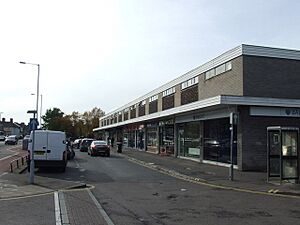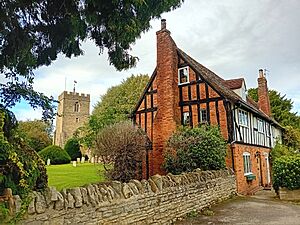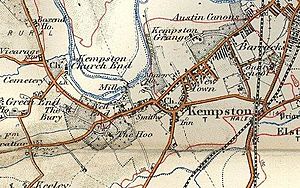Kempston facts for kids
Quick facts for kids Kempston |
|
|---|---|
 Kempston Town Centre |
|
| Population | 20,733 (Parish, 2021) 22,785 (Built-up area, 2021) |
| OS grid reference | TL035485 |
| • London | 54.6 m |
| Civil parish |
|
| Unitary authority | |
| Ceremonial county | |
| Region | |
| Country | England |
| Sovereign state | United Kingdom |
| Post town | BEDFORD |
| Postcode district | MK42 |
| Dialling code | 01234 |
| Police | Bedfordshire |
| Fire | Bedfordshire and Luton |
| Ambulance | East of England |
| EU Parliament | East of England |
| UK Parliament |
|
Kempston is a town and civil parish (a local government area) in the Borough of Bedford, Bedfordshire, England. It's located about 2 miles (3.2 km) south-west of Bedford town centre. In 2011, it had a population of 19,330 people. Kempston is part of the larger Bedford built-up area. The River Great Ouse flows between Kempston and the Queen's Park area of Bedford.
Contents
Kempston's Past: A Look at History
For a long time, until the 1800s, Kempston was mostly a farming area. It was one of the biggest parishes (local areas) in Bedfordshire. Back then, there wasn't one main village. Instead, people lived in smaller groups of homes called "Ends," like Up End, Bell End, Wood End, and Box End.
The main church, All Saints', was in Church End. This area was not the biggest, but it was quite central. In the 1800s, East End, Bell End, and Up End started to grow together. In 1870, builders began to create a new area called "Kempston New Town" on the road to Bedford. This new district grew steadily, and Kempston started to feel more like a town. A military base, Kempston Barracks, was built here in 1876.
On April 1, 1896, Kempston was split into two parts: "Kempston" (which became an Urban District) and "Kempston Rural." The Urban District was closer to Bedford and had most of the people. Kempston Rural was much larger but had fewer residents. Church End, where the original church is, stayed a small hamlet in Kempston Rural.
Around the 1860s, a gravel pit (where gravel is dug from the ground) opened at Hill Grounds. This created many jobs, and the area known as 'Up End' grew because of it. From about 1910 to the early 1930s, a special railway called the Kempston gravel pit railway was used to serve this gravel pit.
Kempston's population grew slowly in the early 1900s, but then it started to grow very quickly. By 1951, the population was nearly 10,000, which was 60% more than in 1931. In the second half of the 1900s, the population almost doubled! In 1974, the Kempston Urban District was removed, and Kempston became part of the Borough of Bedford. However, it still has its own town council that handles local matters.
Kempston's Weather
| Climate data for Kempston (1981–2010) | |||||||||||||
|---|---|---|---|---|---|---|---|---|---|---|---|---|---|
| Month | Jan | Feb | Mar | Apr | May | Jun | Jul | Aug | Sep | Oct | Nov | Dec | Year |
| Mean daily maximum °C (°F) | 6.9 (44.4) |
7.2 (45.0) |
10.3 (50.5) |
12.9 (55.2) |
16.3 (61.3) |
19.3 (66.7) |
22.1 (71.8) |
21.9 (71.4) |
18.7 (65.7) |
14.4 (57.9) |
9.9 (49.8) |
7.0 (44.6) |
13.9 (57.0) |
| Mean daily minimum °C (°F) | 1.2 (34.2) |
0.8 (33.4) |
2.6 (36.7) |
4.0 (39.2) |
6.8 (44.2) |
9.8 (49.6) |
12.0 (53.6) |
12.0 (53.6) |
10.1 (50.2) |
7.1 (44.8) |
3.8 (38.8) |
1.5 (34.7) |
6.0 (42.8) |
| Average precipitation mm (inches) | 49.0 (1.93) |
36.7 (1.44) |
40.8 (1.61) |
47.3 (1.86) |
48.3 (1.90) |
51.4 (2.02) |
49.2 (1.94) |
54.5 (2.15) |
54.9 (2.16) |
62.5 (2.46) |
53.4 (2.10) |
49.7 (1.96) |
597.6 (23.53) |
| Average precipitation days (≥ 1.0 mm) | 10.5 | 8.8 | 9.7 | 9.2 | 9.0 | 8.7 | 8.7 | 8.3 | 8.6 | 9.9 | 10.2 | 10.1 | 111.7 |
| Mean monthly sunshine hours | 63.6 | 83.1 | 106.8 | 168.2 | 201.4 | 183.4 | 197.6 | 187.2 | 138.5 | 109.3 | 66.0 | 54.3 | 1,559.2 |
How Kempston's Population Grew Over Time
| Year | Kempston Urban |
Kempston Rural |
Total |
|---|---|---|---|
| 1671 | – | – | 752 (est) |
| 1801 | – | – | 1,035 |
| 1811 | – | – | 1,161 |
| 1821 | – | – | 1,419 |
| 1831 | – | – | 1,571 |
| 1841 | – | – | 1,699 |
| 1851 | – | – | 1,962 |
| 1861 | – | – | 2,191 |
| 1871 | – | – | 2,706 |
| 1881 | – | – | 3,432 |
| 1891 | – | – | 4,736 |
| 1901 | 4,729 | 719 | 5,448 |
| 1911 | 5,459 | 648 | 5,997 |
| 1921 | 5,218 | 656 | 5,874 |
| 1931 | 5,390 | 730 | 6,120 |
| 1941 | N/A | N/A | No census |
| 1951 | 8,645 | 1,171 | 9,816 |
| 1961 | 9,190 | 1,289 | 10,479 |
| 1971 | 12,826 | 1,306 | 14,132 |
| 1981 | 15,500 | 1,280 | 16,780 |
| 1991 | 17,938 | 1,163 | 19,101 |
| 2001 | 19,440 | ? | see note 2 |
| 2011 | 19,330 | 1,184 | 20,514 |
Note 2: The 2001 Kempston Urban figure is the total for the three urban areas of Kempston East, Kempston North and Kempston South.
What Does the Name "Kempston" Mean?
The old name for Kempston was "kemestun". This name might come from a very old language called Brittonic. The word "cambio" in Brittonic means "bent" or "curved." So, the name could have meant "the settlement on the bend." This might refer to the sharp bends in the River Great Ouse upstream from Bedford.
Another idea is that "cambita" (the curved one) was a name for this part of the river. The name "Kempston" also appears as a family name for many people with British roots. In the Domesday Book (a very old survey from 1086), Kempston was written as "camestone." An Anglo Saxon burial site from the 6th century was found here, which is now the Saxon Centre.
However, it's also possible that the "Caemb" part of the name comes from the name of an Anglo-Saxon person who owned the settlement. The "s" then shows that it belonged to them. This idea seems more likely because the river has many bends, so "the bend" wouldn't help much to find a specific place.
Sports and Fun in Kempston
Kempston has a local football team called A.F.C. Kempston Rovers. They play their games at Hillgrounds Leisure.
For a short time in 1932, there was a greyhound racing track in Kempston. It was run by the Box End (Kempston) Dog Club. This type of racing was "independent," meaning it wasn't part of the main sports group. People called these tracks "flapping tracks." The racing only lasted for two years.
Kempston's Churches
For many hundreds of years, All Saints' Church in Church End was the only place of worship in Kempston. It started as a Catholic church and later became Anglican. The church is in a pretty, green churchyard near the river, and the area still feels rural.
William the Conqueror's niece, Judith, helped build the west tower, nave (main part of the church), and chancel (area around the altar) in 1100. Parts of the church from this early Norman period are still there today. More parts were added in the 1200s. In the 1400s, the windows were changed, and the tower and nave walls were made taller, creating a clerestory (a row of windows high up). The font (a basin for baptisms) is from the 1300s. The church was updated in the 1800s, and galleries were added for children.
As Kempston's population grew, two more Church of England churches were built in the 1800s. St John's in Up End was finished in 1868, but it had problems with sinking ground. For the growing Kempston New Town, a temporary iron church called St Stephen's was built in 1888. Later, in 1927, a local family gave money to build a new church, the Church of the Transfiguration (Transfiguration Church, Kempston), on Bedford Road. This church was finished in 1940 and replaced the two older, less suitable churches. St John's was eventually taken down in 1965.
Methodism became popular in Kempston in the mid-1800s. The first Methodist chapel (a type of church) was built in Bell End in 1839. It was made bigger in 1843. In 1860, a larger chapel was built on High Street. Today, the Kempston West Methodist Church stands on that spot. The Kempston East Methodist Church on Bedford Road opened in 1904 to serve the newer parts of Kempston. It's a beautiful Gothic-style building made of light-colored stone.
Kempston is close to Elstow, where John Bunyan (who wrote The Pilgrim's Progress) lived, and Bedford, where he was imprisoned. The church in Bedford, now called the Bunyan Meeting, had members in Kempston as early as 1657. The first Congregationalist church building in Kempston opened on High Street in 1813. A new one was built in Kempston New Town in 1871.
Before World War II, Roman Catholics in Kempston had to go to church in Bedford. During the war, a Catholic chapel was set up at the Army's Grange Camp. After the war, it stayed open. The first Catholic priest in Kempston was appointed in 1965, and the current Catholic church on Bedford Road was built around that time.
The Church of Jesus Christ of Latter-day Saints (often called the LDS Church or Mormon Church) was first introduced in Bedford and Kempston in 1837 by a missionary named Willard Richards. Bedfordshire was one of the first places in the UK to have an LDS Church. Kempston still has Mormon missionaries, and the number of members is growing. In 1986, the LDS Church built its Bedford Chapel/Meetinghouse near Addison Park.
Learning in Kempston: Schools
Kempston has four primary schools: Balliol Primary School, Bedford Road Primary School, Camestone School, and Springfield Primary School. Kempston Rural Primary School serves the rural area. There are two secondary schools in Kempston: Kempston Academy and Daubeney Academy.
Grange Academy, Ridgeway School, and St John's School are also in Kempston. These are special requirements schools for students from all over the Bedford area.
Important Places and Buildings
Addison Howard Park is Kempston's main park. It used to be part of the grounds of Grange House, a large old home that is now flats. The Howard family, who owned a big iron works in Bedford, owned this estate in the 1880s. Grange House was later given to the people of Kempston by the Howard family. The park has an indoor swimming pool that opened in the 1980s.
Kempston's Sainsbury's supermarket was the biggest one in the chain when it first opened in the 1970s. The main office for the Bedfordshire Police is also located in Kempston.
Besides All Saints' Church, two other well-known historic buildings are the King William IV pub and Kempston Barracks. The King William pub is a timber-framed building with a distinctive black and white outside. Its exterior is from the 1600s, but parts of it are thought to be much older, from medieval times.
Kempston in the News: Media
Local news and TV shows for Kempston come from BBC East and ITV Anglia. TV signals are received from the Sandy Heath TV transmitter.
You can listen to local radio stations like BBC Three Counties Radio (95.5 FM), Heart East (96.9 FM), In2beats (106.5 FM), and Bedford Radio, which is a community station online.
The town's local newspaper is Bedford Today, which used to be called Times & Citizen.
Getting Around: Transport in Kempston
Train Travel
The train stations of Bedford and Bedford St Johns are about 1.5 miles (2.4 km) north-east of Kempston. Bedford station has longer-distance trains on the Midland Main Line and local trains on the Marston Vale Line. Bedford St Johns station only has trains on the Marston Vale Line.
Roads and Driving
The Bedford Southern Bypass, part of the A421, was built in the 1990s. It connects to the Kempston relief road, which was built in the 1980s. Along this road, you'll find a shopping area called Kempston Interchange Retail Park. Big distribution centers for companies like Asda, Argos, and Sainsbury's have opened at the Marsh Leys site since the early 2000s.
In 2007, work started on the Bedford Western Bypass, which opened in 2010. This road goes through Kempston Rural and crosses the River Great Ouse. In 2010, a new section of the A421 was finished, connecting Kempston to Junction 13 of the M1 motorway. This new road provides a full dual carriageway (a road with two lanes in each direction) link between the A1 and the M1.
Bus Services
Most bus services in Kempston connect to other places in Bedfordshire and Milton Keynes. Bus companies like Uno, Stagecoach, and Road Runner serve the town with various routes.
Famous People from Kempston
- Frances Latham (1609–1677) was born in Kempston. She was the daughter of Sir Lewis Latham, who was the falconer (someone who trains falcons) for King Charles I. Frances later moved to Rhode Island in America. Many of her descendants became important leaders, state governors, and famous people, earning her the nickname "the Mother of Governors."
See also
 In Spanish: Kempston para niños
In Spanish: Kempston para niños





